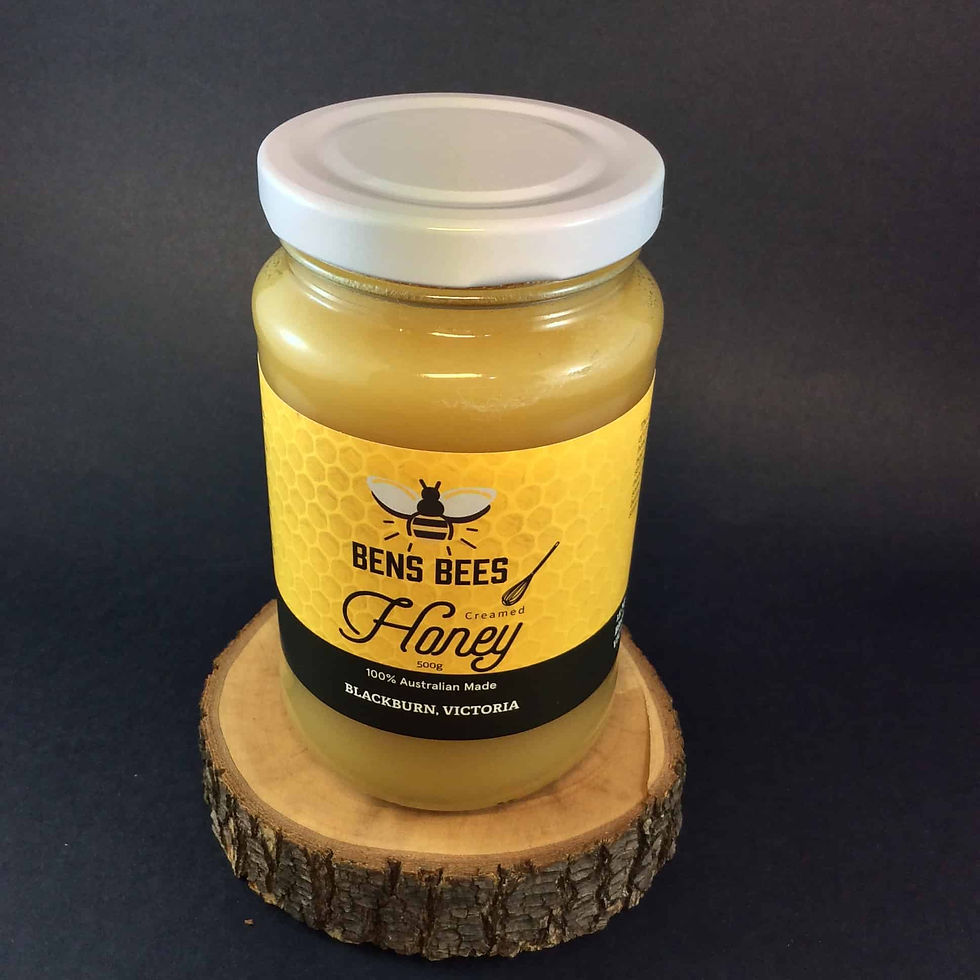Ben's Bees Creamed Honey 500g
Ben’s Bees creamed honey is raw, local and made with love by happy bees.
What is creamed honey? You won’t forget once you’ve tried it – it’s amazing!
Creamed honey is also known as whipped honey, churned honey, spun honey and even ‘honey fondant’. This naturally conjures up thoughts of a thick, creamy consistency, and of the type of process that is likely to be involved, but the reality is far different!
Honey will naturally crystallise with age; this occurs when the sugars harden and the honey thickens as a result. This process is completely normal and does not mean that the honey has gone off or spoilt as some people may think. The easiest way to reconstitute the honey back to its original pouring consistency is to place the jar of honey in some warm water. Be careful, because much hotter than about 40C and you run the risk of killing all the good enzymes, vitamins and minerals.
Creamed honey is actually honey that has undergone controlled crystallisation. The crystals are incredibly fine – much smaller than normal – giving it the luxurious feel of double cream on the tongue! Production involves adding a ‘creamed honey culture’ which then starts to spread throughout the honey, creating those fine crystals. The entire process may take anything from a few weeks up to a number of months to complete, depending on the sugar structure of the honey.
What do with creamed honey? Well, it has an irresistibly smooth, spreadable consistency. Use it in exactly the same way as you would any other honey. Add a little creamed honey to buttered crumpets for a yummy breakfast dish that’s hard to beat!
Made in Blackburn North, Victoria, Australia
DETAILS
Humans and Honey.
Humans have been collecting wild honey for at least 15,000 years, and the domestication of the honey bee became one of the first forms of agriculture, about 9,000 years ago. Honey and the honey bee have become significant symbols of sweetness and fertility in many cultures. In addition to its importance as a natural sweetener, honey has traditionally been used as a preservative and to alleviate a variety of medical complaints.
An 8,000-year-old cave painting in Valencia, Spain, depicts two figures using baskets and ladders to collect wild honey. For thousands of years, honey hunters in Africa have followed small birds called honeyguides to locate bees’ nests and harvest honey. This has led to the formation of a unique relationship that benefits both man and bird. The hunters use special calls to communicate with the birds, which in turn actively seek out the hunters and guide them to the bees’ nests. The honeyguides feed upon bees’ eggs and larvae and beeswax, and rely upon their human partners to break open the hive.
In what remains the earliest evidence of apiculture, traces of beeswax have been found upon pottery dating back almost 9,000 years from ancient Turkey. The earliest-known honey was recovered from clay vessels in a tomb in Georgia from about 5,000 years ago. Several varieties of honey were interred with the local people to assist in their journey to the afterlife. Beekeeping is recorded from Egypt 4,500 years ago, where honey was used extensively in cooking, treating medical ailments and embalming the dead. To the Egyptians, the bee often symbolised royalty and fertility, and honey has been discovered in royal tombs, including that of Tutankhamun.
Other ancient writings also make frequent references to honey, including Sumerian and Babylonian cuneiform texts, dated to around 2100 BC, and the Hittite code. Honey was a vital sweetener in Greek and Roman cuisine, and the ancient Greeks were fervent believers in the healing properties of honey, which was considered to be the ‘food of the gods’. Greek beekeepers would move their hives considerable distances to take advantage of regional vegetative cycles and optimise production, and by the 6th century BC, beekeeping had become so widespread in Greece that a law was passed to regulate the location of new hives. Beekeeping flourished throughout the Roman empire, and the advent of Christianity created great demand for beeswax candles.
Honey is mentioned more than 50 times in the bible, and the Promised Land is described as flowing with milk and honey. An apiary dating from the 10th century BC has been excavated in Tel Rehov, in Israel’s Beth Shean Valley, that is estimated to have contained 100 hives and produced half a ton of honey annually. Pure honey is considered kosher even though, strictly speaking, bees are not. In fact, honey symbolises the Jewish new year, Rosh Hashanah, when apple slices dipped in honey are traditional fare.
Honey bees have also been cultivated in China since ancient times, and honey is frequently used in traditional Chinese medicine. Similarly, ancient Indian texts (the Vedas and the Ayurveda, the origins of which can be traced back 4,000 years) document the use of honey for spiritual and therapeutic purposes. Honey has significance in Hinduism as one of the elixirs of immortality, and in Buddhism as part of the festival of Madhu Purnima. The Qur’an promotes the nutritional and medicinal value of honey, and an entire chapter is entitled ‘The Bee’. Honey bees are native to Europe, Asia and Africa, and were introduced to North America by western settlers in the early 1600s. However, the native peoples of Mexico and Central America traditionally kept stingless bees and still uses this honey for culinary purposes.
The importance of honey is intrinsically woven into human history. In medieval Europe, it was often used as a form of currency. Napoleon chose the bee to be his emblem as emperor; symbolising diligence and orderliness, and also (as the producer of honey) sweetness and benevolence. Cupid was reputed to dip his arrows in honey to make them irresistible to his unsuspecting targets.
***
thank you for supporting
small business + sustainable organics

